Evaluation of Workability and Structuration Rate of Locally Developed 3D Printing Concrete Using Conventional Methods
Abstract
:1. Introduction
- Develop 3D printing concrete utilizing available construction materials and evaluate its workability using commonly used devices in the construction industry (slump and flow tests) to determine the ranges at which extrudability and buildability are satisfied.
- Study the structuration rate of concrete using simple devices such as the slump, flow, and penetration tests. The results of the present investigation are expected to encourage researchers to use and explore simple equipment that can facilitate and standardize the evaluation of fresh printing concrete in the future.
- Study the effect of structuration rate on certain properties of printing concrete such as buildability and compressive strength.
2. Experimental Program
2.1. Materials
2.2. Mixing and Printing Procedure
2.3. Tests Conducted
2.3.1. Extrudability
2.3.2. Setting Time and Open Time
2.3.3. Workability
2.3.4. Buildability
2.3.5. Compressive Strength
3. Results and Discussion
3.1. Phase 1 Evaluation
3.1.1. Group I
3.1.2. Group II
3.2. Phase 2 Evaluation
3.2.1. Setting Time and Open Time
3.2.2. Comparison of Workability Indicators with Extrudability and Structuration Rate
3.2.3. Pearson Correlation Analysis
3.2.4. Buildability
3.2.5. Compressive Strength
3.2.6. Optimum 3D Printing Concrete Mix
4. Conclusions
- Mixing using the conventional mixer requires more time as compared to the Hobart mixer. The mixing time was significantly increased from 5 min on the Hobart mixer to 40 min on the conventional mixer as a result of changes in mixing speed/technique. This emphasizes the importance of optimizing the mixing time when using different concrete mixers. Overall, the conventional mixer was adequate to prepare mixes with 0.26 water-to-binder (w/b) ratio; however, for lower ratios, other high-energy mixers may be required.
- The workability results suggest that the optimal ranges to satisfy the extrudability are in the ranges of 85–9 mm and 90–56%, respectively. However, the lower limit may differ from one study to another, depending on the properties of the printer used.
- The structuration rate was indicated by the loss of each of the flow, slump, and penetration with time. From the Pearson correlation analysis results, it is suggested that flow and penetration provide the best indication of the structuration rate of concrete as compared to slump, and thus it is recommended to correlate these results with the rheological properties.
- The higher aggregate-to-binder (a/b) ratio increased both the buildability and compressive strength of cast specimens. However, for the printed specimens, the strength decreased with the increase in a/b ratio. The decrease was mainly due to an increase in thixotropy. This suggests that the optimal mix in this study was the 1.2 mix, and higher a/b ratios are not preferred for 3D printing or have to be used alongside other materials that lower the thixotropy to avoid the formation of weak interfaces.
Author Contributions
Funding
Institutional Review Board Statement
Informed Consent Statement
Data Availability Statement
Acknowledgments
Conflicts of Interest
Disclaimer
References
- News Release Bureau of Labor Statistics US Department of Labor. Available online: https://www.bls.gov/news.release/pdf/cfoi.pdf (accessed on 11 November 2021).
- Worrell, E.; Price, L.; Martin, N.; Hendriks, C.; Meida, L.O. Carbon Dioxide Emissions From the Global Cement Industry. Annu. Rev. Energy Environ. 2001, 26, 303–329. [Google Scholar] [CrossRef]
- Ahmed, S.; Al-Dawood, Z.; Abed, F.; Mannan, M.A.; Al-Samarai, M. Impact of using different materials, curing regimes, and mixing procedures on compressive strength of reactive powder concrete—A review. J. Build. Eng. 2021, 44, 103238. [Google Scholar] [CrossRef]
- Ma, G.W.; Wang, L.; Ju, Y. State-of-the-art of 3D printing technology of cementitious material—An emerging technique for construction. Sci. China Technol. Sci. 2018, 61, 475–495. [Google Scholar] [CrossRef]
- Le, T.T.; Austin, S.A.; Lim, S.; Buswell, R.A.; Gibb, A.G.F.; Thorpe, T. Mix design and fresh properties for high-performance printing concrete. Mater. Struct. 2012, 45, 1221–1232. [Google Scholar] [CrossRef] [Green Version]
- Xiao, J.; Ji, G.; Zhang, Y.; Ma, G.; Mechtcherine, V.; Pan, J.; Wang, L.; Ding, T.; Duan, Z.; Du, S. Large-scale 3D printing concrete technology: Current status and future opportunities. Cem. Concr. Compos. 2021, 122, 104115. [Google Scholar] [CrossRef]
- Starr, M. World’s First 3D-Printed Apartment Building Constructed in China. Available online: https://www.cnet.com/news/worlds-first-3d-printed-apartment-buildingconstructed-in-china/ (accessed on 12 November 2021).
- Garofalo, F. The World’s First 3D Printed Office Is in Dubai. Available online: https://www.lifegate.com/worlds-first-3d-printed-office-building-dubai#:~:text=Printed in 17 days and,printed office%2C lo-cated in Dubai (accessed on 27 February 2021).
- Office of the Future/Kila Design. Available online: https://www.archdaily.com/875642/office-of-the-future-killa-design (accessed on 25 February 2021).
- Dubai Unveils World’s Largest 3D Printed Two-Storey Building. Available online: https://www.thenational.ae/uae/government/dubai-unveils-world-s-largest-3d-printed-two-storey-building-1.927590#3 (accessed on 26 February 2021).
- Siddika, A.; Al Mamun, A.; Ferdous, W.; Saha, A.K.; Alyousef, R. 3D-printed concrete: Applications, performance, and challenges. J. Sustain. Cem. Mater. 2020, 9, 127–164. [Google Scholar] [CrossRef]
- Malaeb, Z.; Hachem, H.; Tourbah, A.; Maalouf, T.; el Zarwi, N.; Hamzeh, F. 3D Concrete Printing: Machine and Mix Design. Int. J. Civ. Eng. 2015, 6, 14–22. [Google Scholar]
- Zhang, Y.; Zhang, Y.; Liu, G.; Yang, Y.; Wu, M.; Pang, B. Fresh properties of a novel 3D printing concrete ink. Constr. Build. Mater. 2018, 174, 263–271. [Google Scholar] [CrossRef]
- Ma, G.; Li, Z.; Wang, L. Printable properties of cementitious material containing copper tailings for extrusion based 3D printing. Constr. Build. Mater. 2018, 162, 613–627. [Google Scholar] [CrossRef]
- Hu, J.A. A Study of Effects of Aggregate on Concrete Rheology. Ph.D. Thesis, Iowa State University, Ames, IA, USA, 2006. [Google Scholar]
- Roussel, N. Rheological requirements for printable concretes. Cem. Concr. Res. 2018, 112, 76–85. [Google Scholar] [CrossRef]
- Perrot, A.; Rangeard, D.; Pierre, A. Structural built-up of cement-based materials used for 3D-printing extrusion techniques. Mater. Struct. 2016, 49, 1213–1220. [Google Scholar] [CrossRef]
- Zhang, Y.; Zhang, Y.; She, W.; Yang, L.; Liu, G.; Yang, Y. Rheological and harden properties of the high-thixotropy 3D printing concrete. Constr. Build. Mater. 2019, 201, 278–285. [Google Scholar] [CrossRef]
- Panda, B.; Singh, G.B.; Unluer, C.; Tan, M.-J. Synthesis and characterization of one-part geopolymers for extrusion based 3D concrete printing. J. Clean. Prod. 2019, 220, 610–619. [Google Scholar] [CrossRef]
- Siddika, A.; Hajimohammadi, A.; Mamun, M.A.A.; Alyousef, R.; Ferdous, W. Waste Glass in Cement and Geopolymer Concretes: A Review on Durability and Challenges. Polymers 2021, 13, 2071. [Google Scholar] [CrossRef]
- Ahmed, S.; Alhoubi, Y.; Elmesalami, N.; Yehia, S.; Abed, F. Effect of recycled aggregates and treated wastewater on concrete subjected to different exposure conditions. Constr. Build. Mater. 2021, 266, 120930. [Google Scholar] [CrossRef]
- Sooryanarayana, K.P.; Stynoski, P.; Lange, D. Effect of Vibration on the Rheology of Concrete for 3D Printing. In Proceedings of the RILEM International Conference on Concrete and Digital Fabrication, Eindhoven, The Netherlands, 8 July 2020; Springer: Cham, Switzerland, 2020; pp. 353–359. [Google Scholar]
- Rahul, A.V.; Santhanam, M.; Meena, H.; Ghani, Z. 3D printable concrete: Mixture design and test methods. Cem. Concr. Compos. 2019, 97, 13–23. [Google Scholar] [CrossRef]
- Dzuy, N.Q.; Boger, D.V. Yield Stress Measurement for Concentrated Suspensions. J. Rheol. 1983, 27, 321–349. [Google Scholar] [CrossRef]
- Souza, M.T.; Ferreira, I.M.; Guzi de Moraes, E.; Senff, L.; Novaes de Oliveira, A.P. 3D printed concrete for large-scale buildings: An overview of rheology, printing parameters, chemical admixtures, reinforcements, and economic and environmental prospects. J. Build. Eng. 2020, 32, 101833. [Google Scholar] [CrossRef]
- Feys, D.; Khayat, K.H. Comparing Rheological Properties of SCC Obtained with the ConTec and ICAR Rheometers. In Proceedings of the Fifth North American Conference on the Design and Use of Self-Consolidating Concrete, Chicago, IL, USA, 12–15 May 2013. [Google Scholar]
- Moeini, M.A.; Hosseinpoor, M.; Yahia, A. Effectiveness of the rheometric methods to evaluate the build-up of cementitious mortars used for 3D printing. Constr. Build. Mater. 2020, 257, 119551. [Google Scholar] [CrossRef]
- Mazhoud, B.; Perrot, A.; Picandet, V.; Rangeard, D.; Courteille, E. Underwater 3D printing of cement-based mortar. Constr. Build. Mater. 2019, 214, 458–467. [Google Scholar] [CrossRef]
- BS EN 197-1. In Raising Standards Worldwide TMBSI Standards Publication Cement Part 1: Composition, Specifications and Conformity Criteria for Common Cements; BSI: London, UK, 2011.
- EN 15167-1. In Ground Granulated Blast Furnace Slag for Use in Concrete, Mortar and Grout-Part 1: Definitions, Specifications and Conformity Criteria; BSI: London, UK, 2006.
- Kazemian, A.; Yuan, X.; Cochran, E.; Khoshnevis, B. Cementitious materials for construction-scale 3D printing: Laboratory testing of fresh printing mixture. Constr. Build. Mater. 2017, 145, 639–647. [Google Scholar] [CrossRef]
- ASTM C191. In Standard Test Methods for Time of Setting of Hydraulic Cement by Vicat Needle 1; ASTM International: West Conshohocken, PA, USA, 2019.
- ASTM C1437. In C01 Committee Specification for Flow of Hydraulic Cement Mortar; ASTM International: West Conshohocken, PA, USA, 2021.
- ASTM C 230. In Standard Specification for Flow Table for Use in Tests of Hydraulic Cement; ASTM International: West Conshohocken, PA, USA, 2021.
- Wolfs, R.J.M.; Bos, F.P.; Salet, T.A.M. Early age mechanical behaviour of 3D printed concrete: Numerical modelling and experimental testing. Cem. Concr. Res. 2018, 106, 103–116. [Google Scholar] [CrossRef]
- Jayathilakage, R.; Rajeev, P.; Sanjayan, J. Yield stress criteria to assess the buildability of 3D concrete printing. Constr. Build. Mater. 2020, 240, 117989. [Google Scholar] [CrossRef]
- Baz, B.; Remond, S.; Aouad, G. Influence of the mix composition on the thixotropy of 3D printable mortars. Mag. Concr. Res. 2021, 1–13. [Google Scholar] [CrossRef]
- ASTM C 109. In C01 Committee Test Method for Compressive Strength of Hydraulic Cement Mortars (Using 2-in. or [50-mm] Cube Specimens); ASTM International: West Conshohocken, PA, USA, 2020.
- Ahmed, S.; Mahaini, Z.; Abed, F.; Mannan, M.A.; Al-Samarai, M. Materials Microstructure and Mechanical Property Evaluation of Dune Sand Reactive Powder Concrete Subjected to Hot Air Curing. Materials 2021, 15, 41. [Google Scholar] [CrossRef]
- Zareiyan, B.; Khoshnevis, B. Effects of interlocking on interlayer adhesion and strength of structures in 3D printing of concrete. Autom. Constr. 2017, 83, 212–221. [Google Scholar] [CrossRef]
- Feng, P.; Meng, X.; Chen, J.-F.; Ye, L. Mechanical properties of structures 3D printed with cementitious powders. Constr. Build. Mater. 2015, 93, 486–497. [Google Scholar] [CrossRef] [Green Version]
- Wolfs, R.J.M.; Bos, F.P.; Salet, T.A.M. Hardened properties of 3D printed concrete: The influence of process parameters on interlayer adhesion. Cem. Concr. Res. 2019, 119, 132–140. [Google Scholar] [CrossRef]
- Le, T.T.; Austin, S.A.; Lim, S.; Buswell, R.A.; Law, R.; Gibb, A.G.F.; Thorpe, T. Hardened properties of high-performance printing concrete. Cem. Concr. Res. 2012, 42, 558–566. [Google Scholar] [CrossRef] [Green Version]
- Keita, E.; Bessaies-Bey, H.; Zuo, W.; Belin, P.; Roussel, N. Weak bond strength between successive layers in extrusion-based additive manufacturing: Measurement and physical origin. Cem. Concr. Res. 2019, 123, 105787. [Google Scholar] [CrossRef]

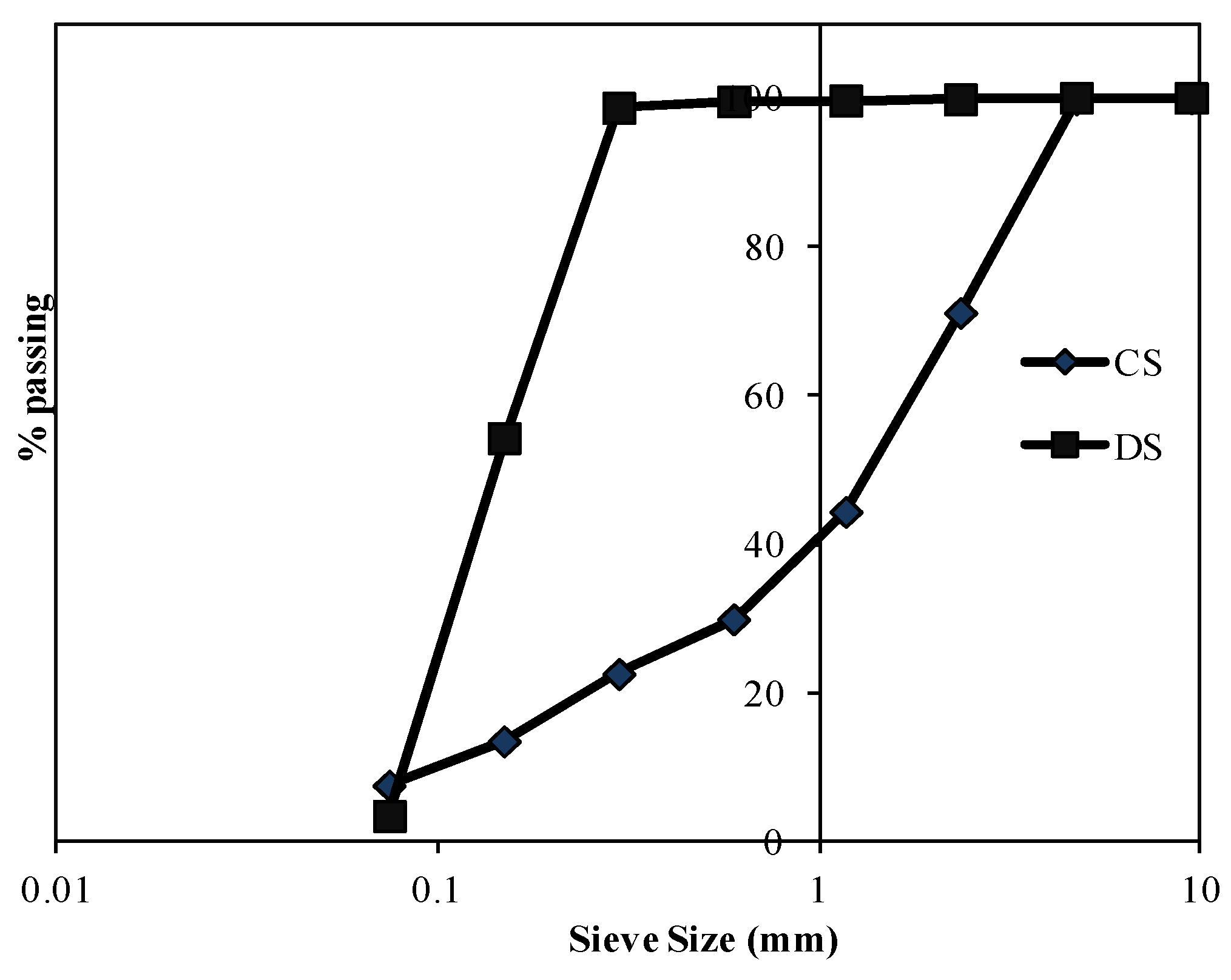

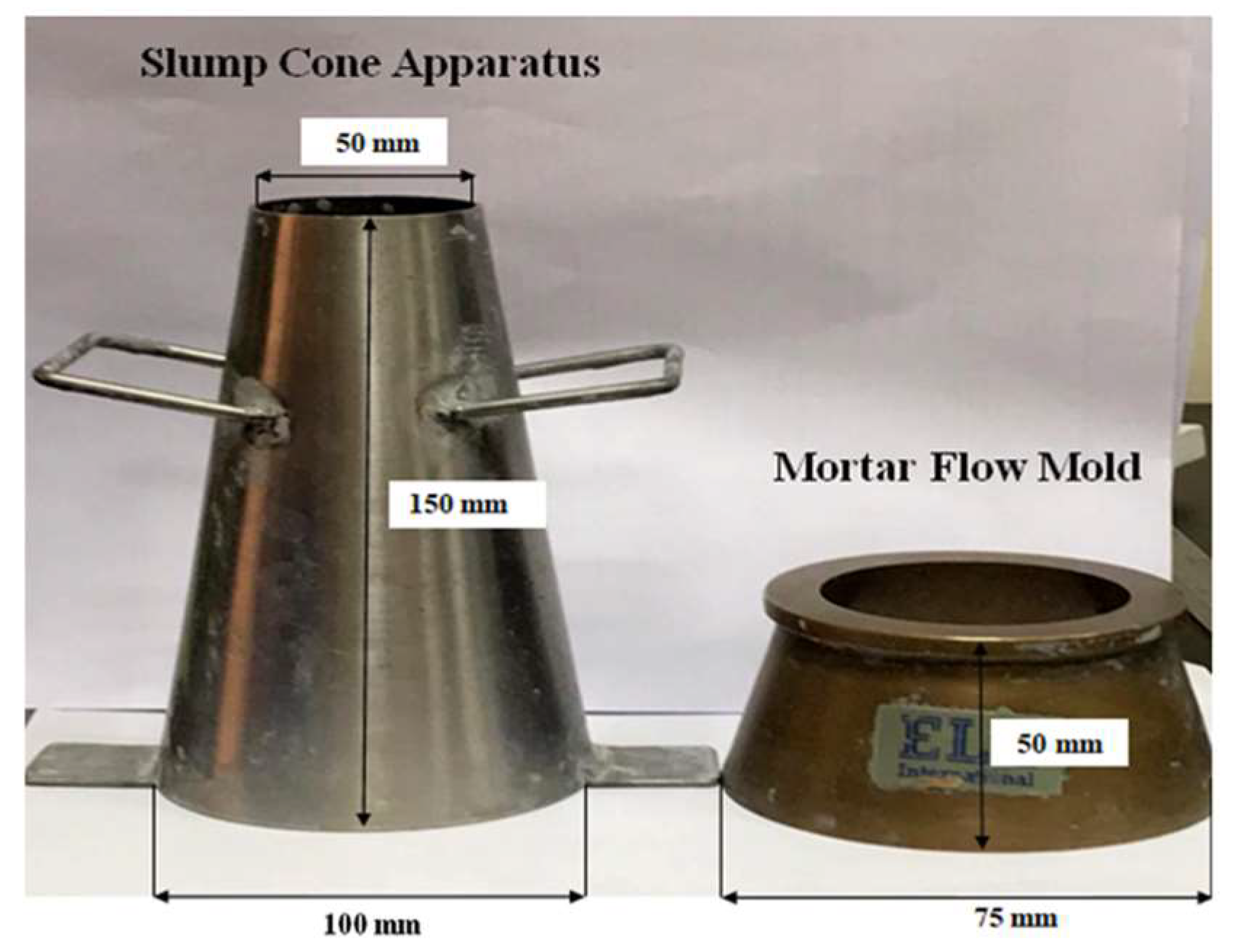
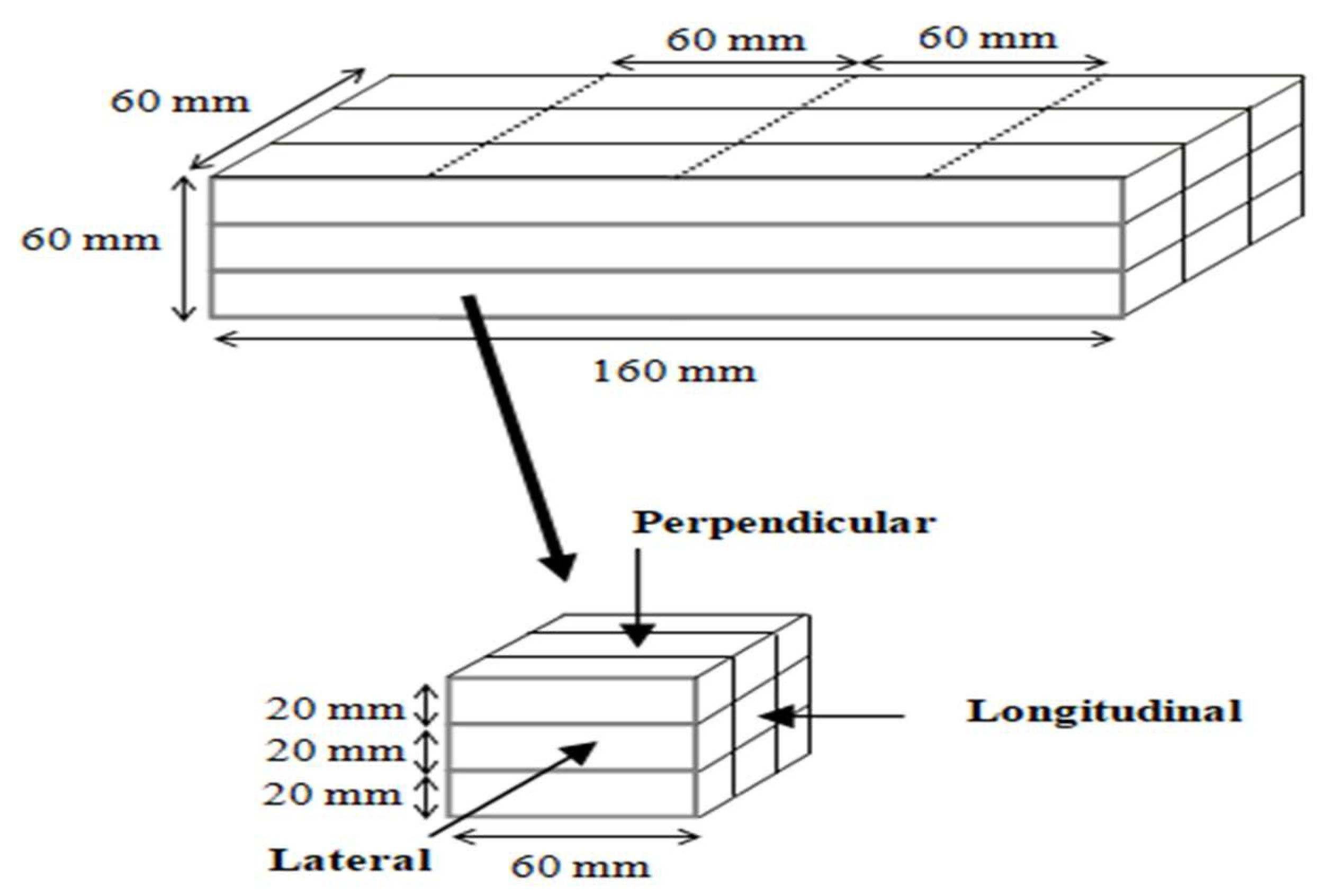
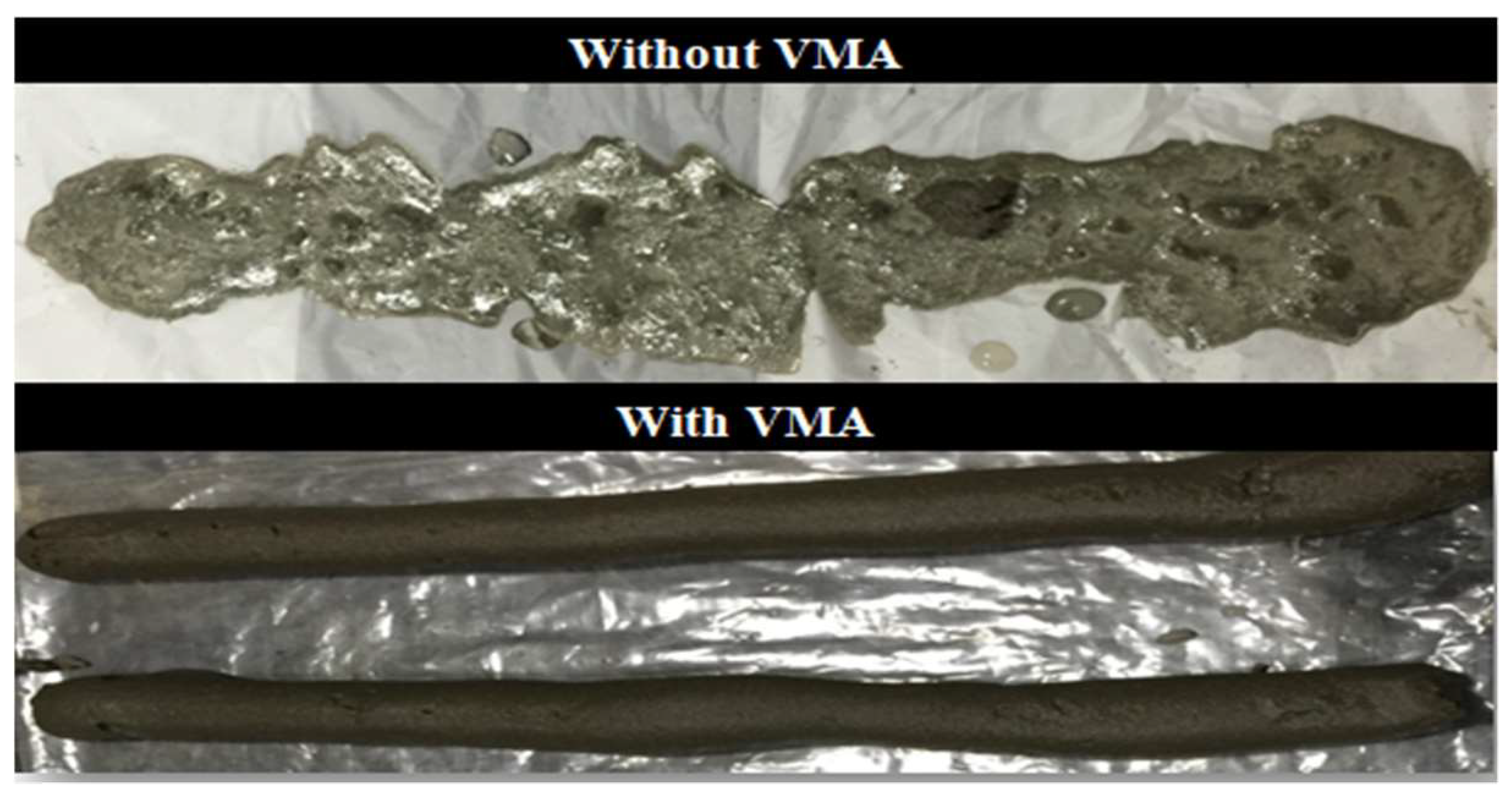
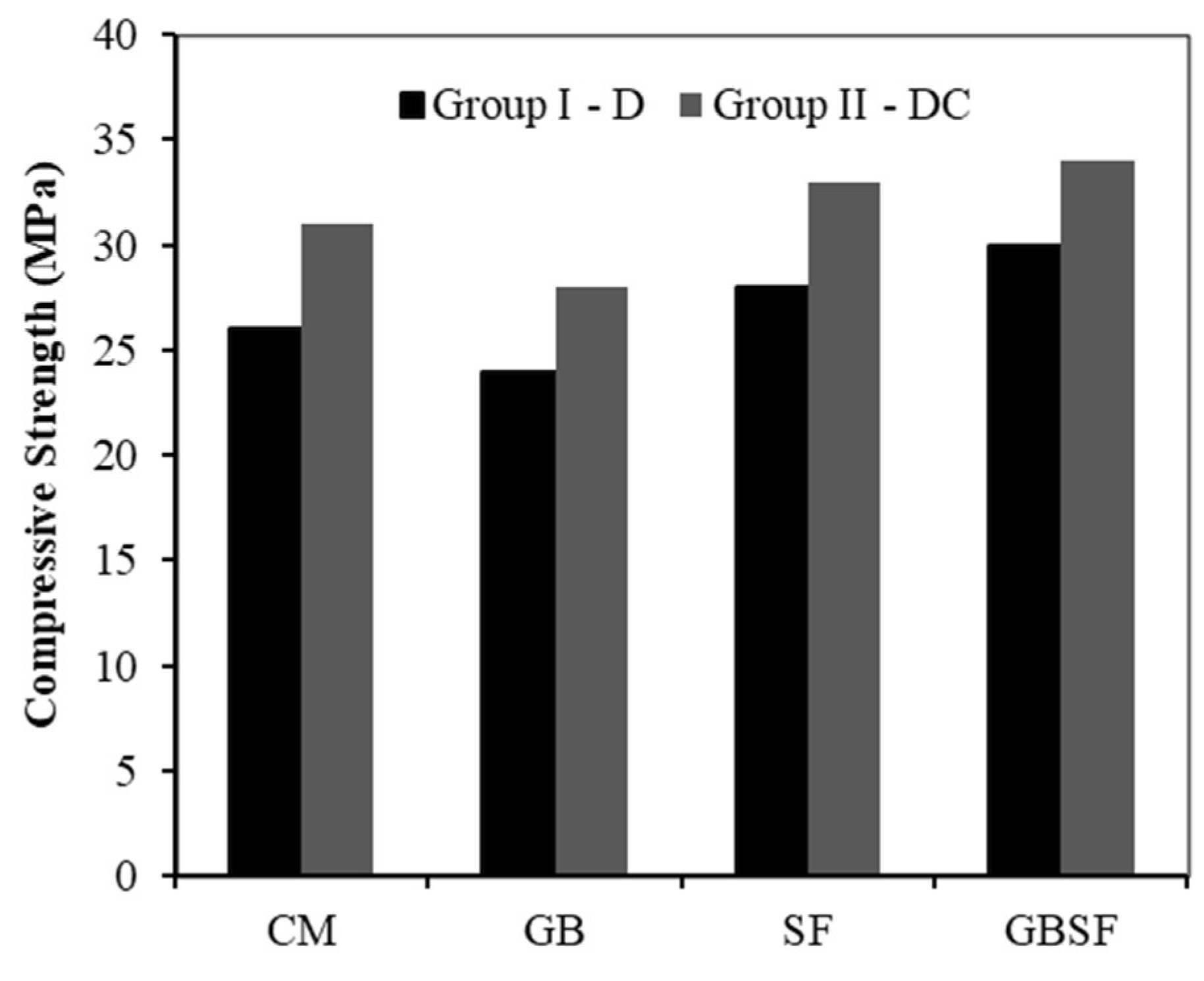
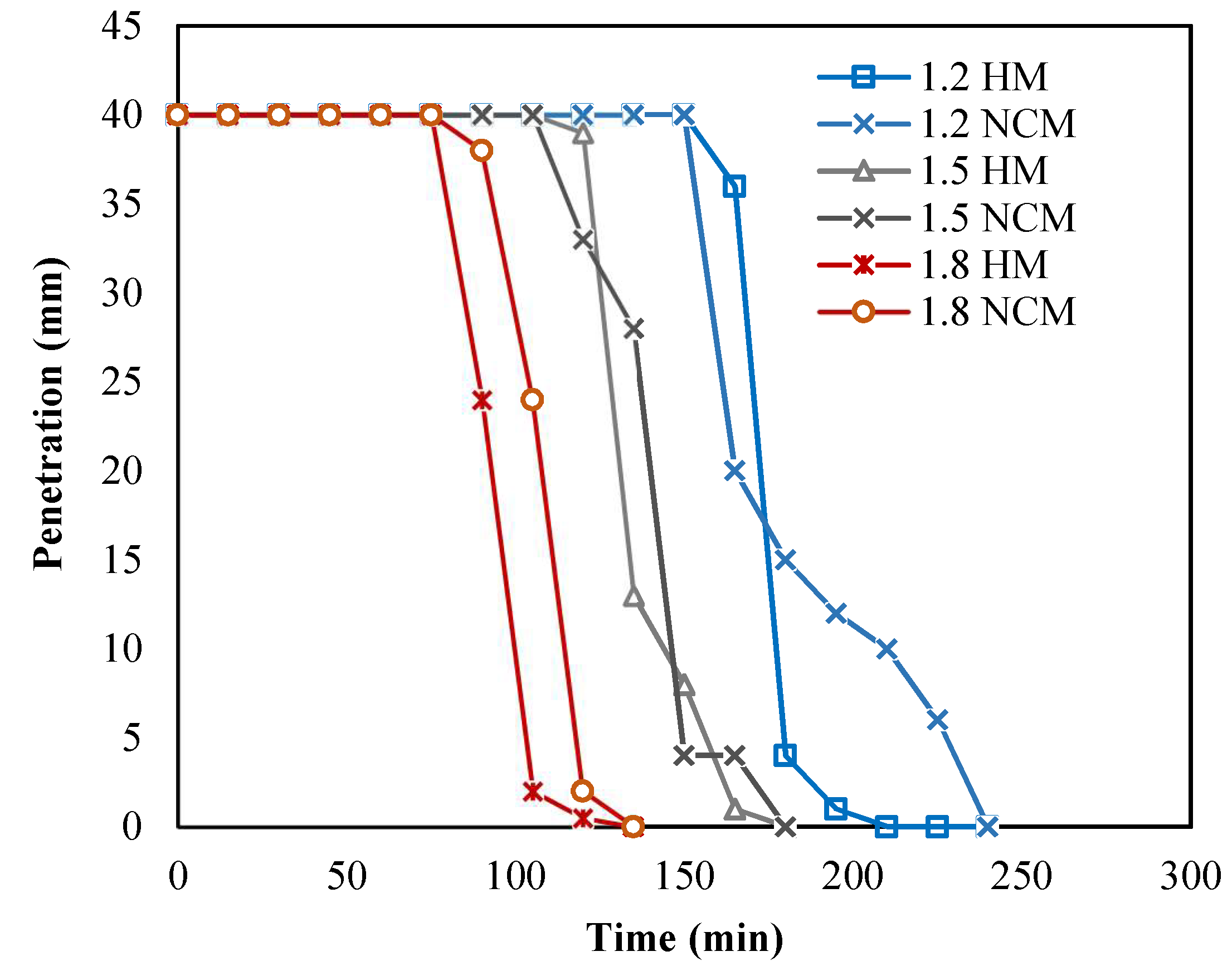

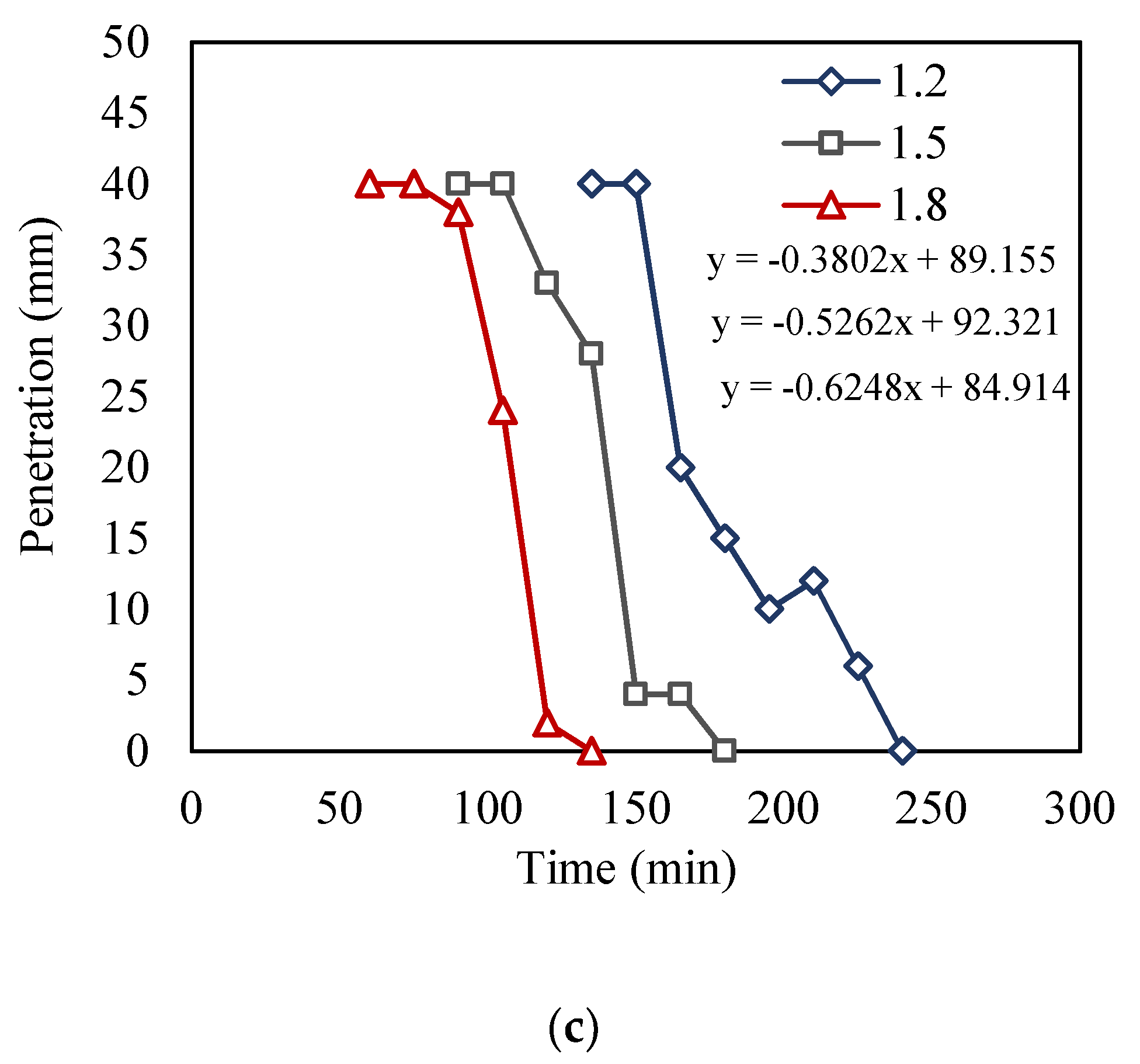
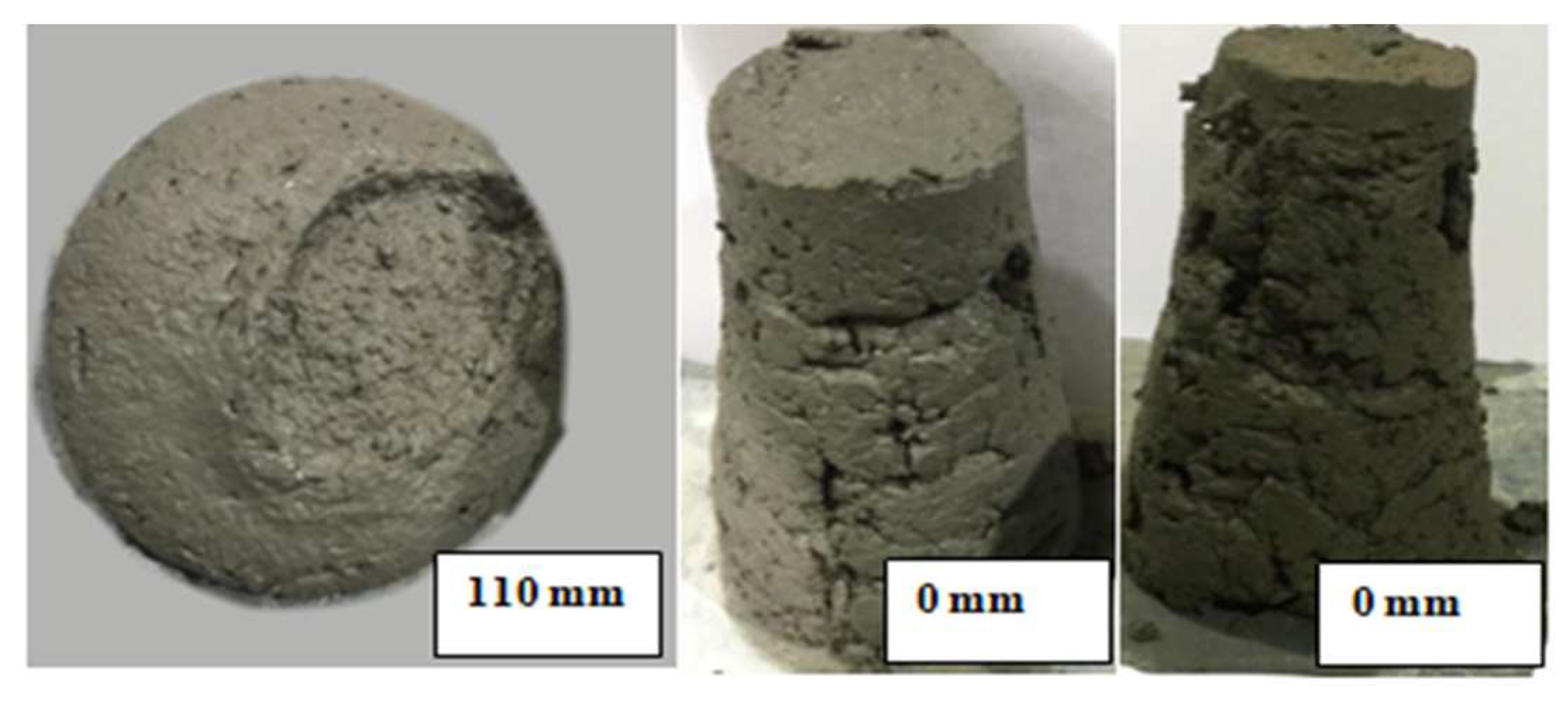


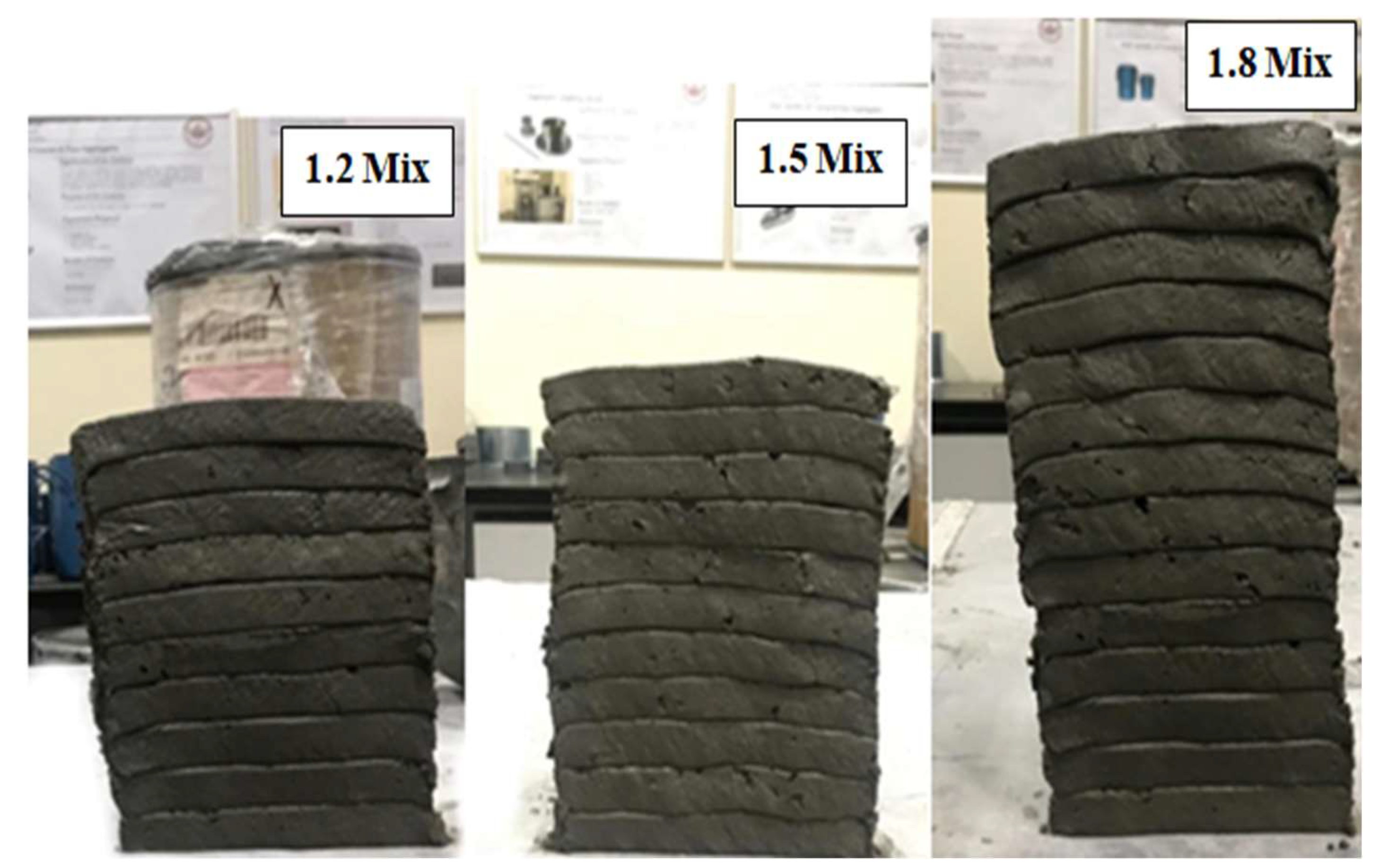
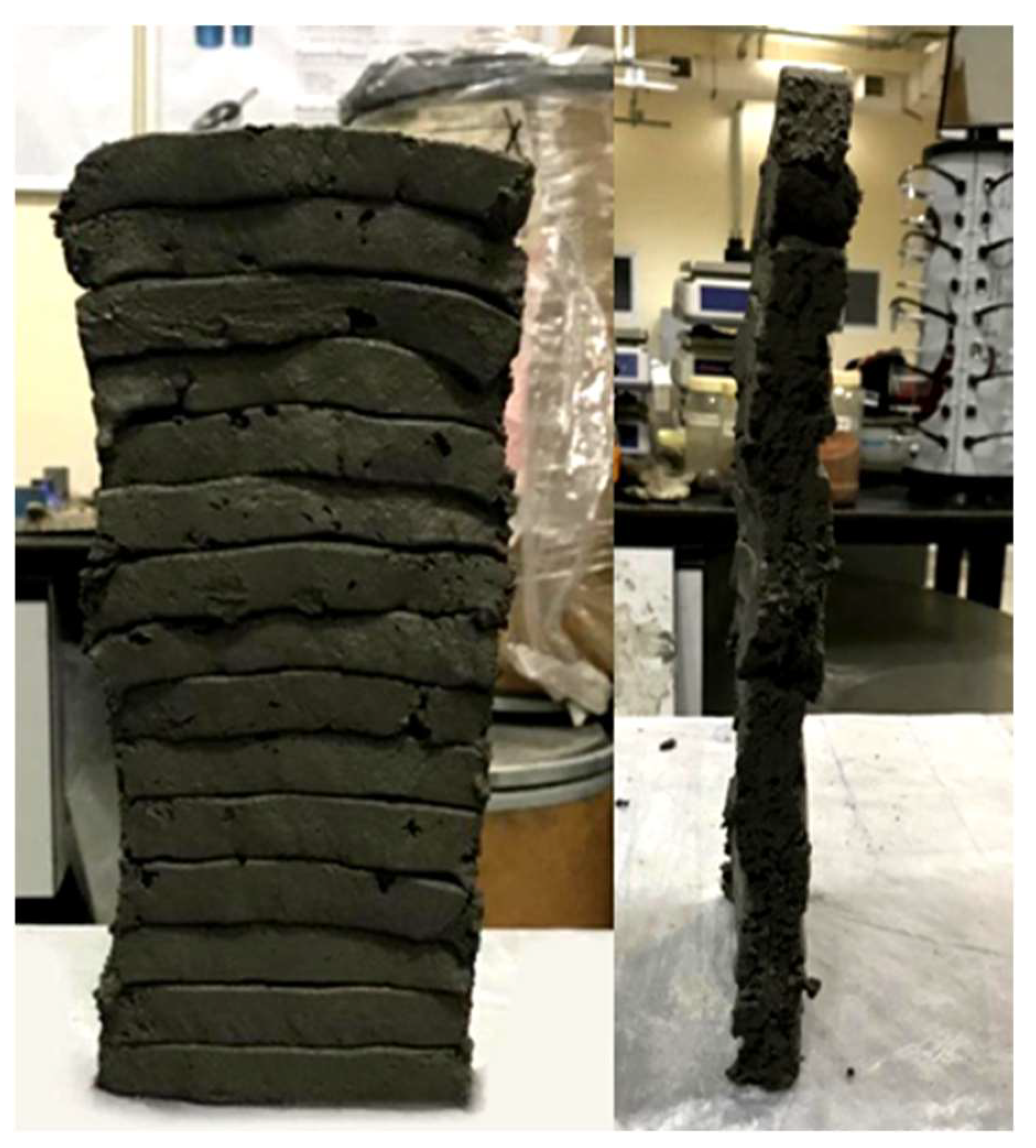
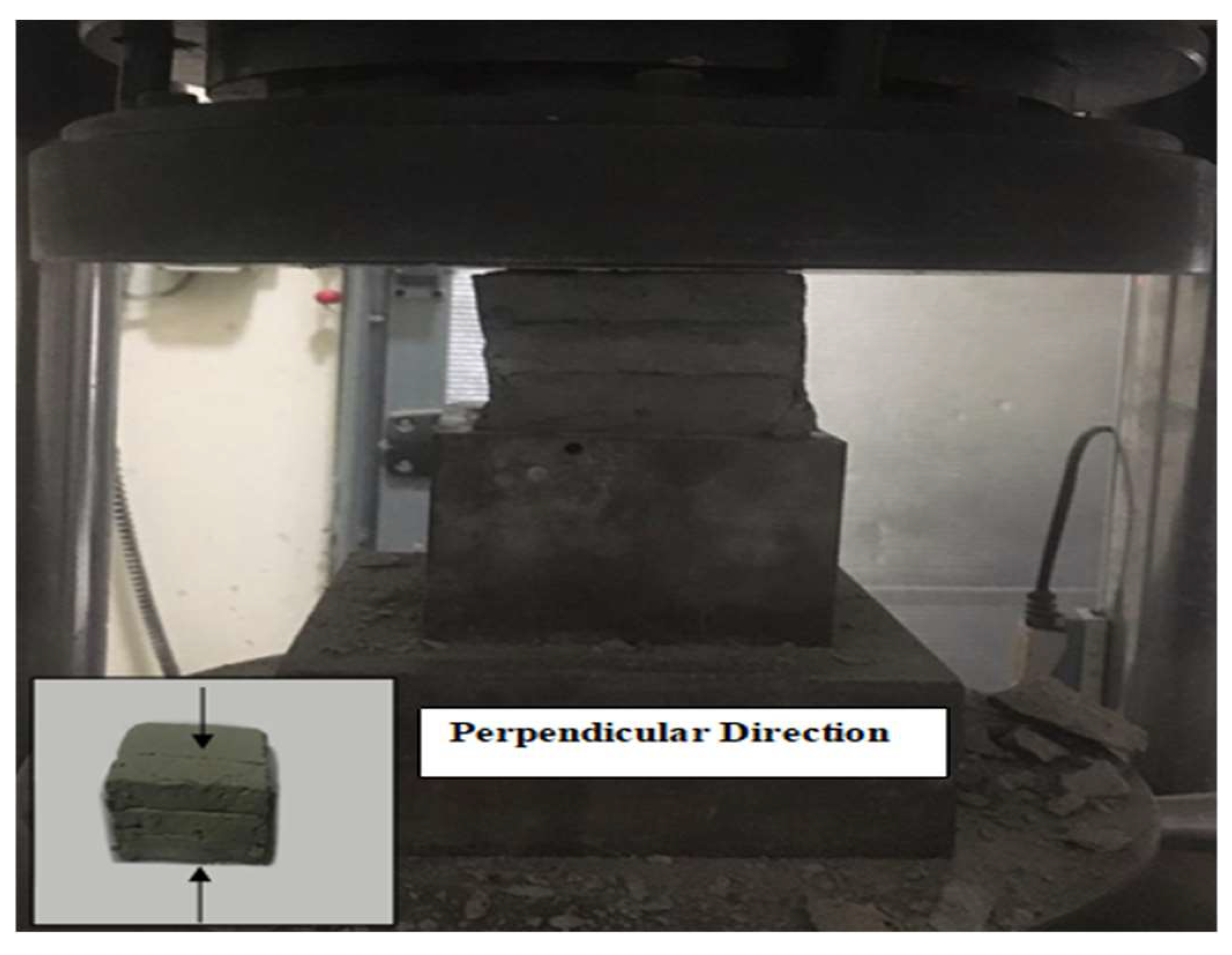
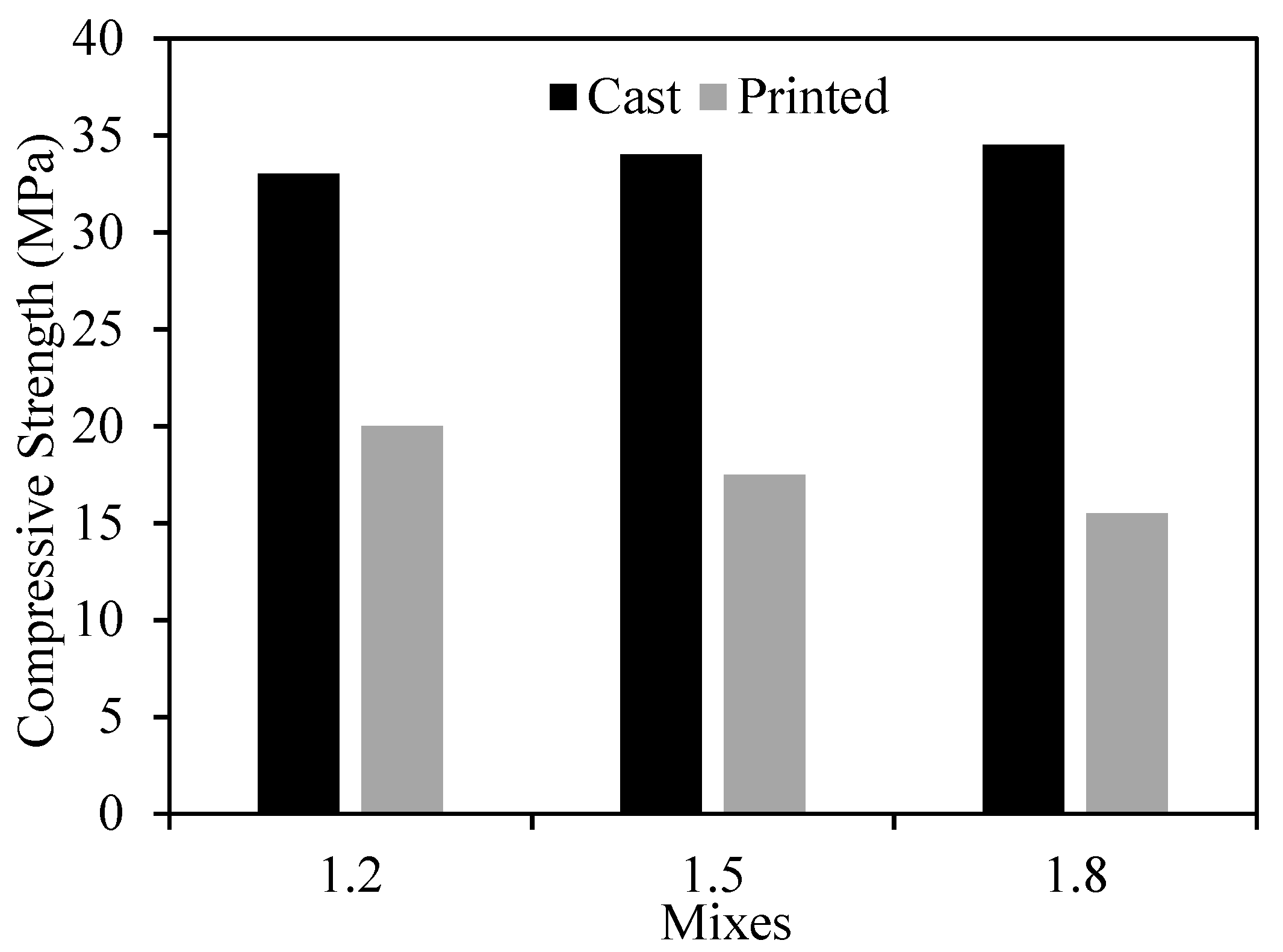

| Reference | Test Method | Description/Standard | Acceptable Range |
|---|---|---|---|
| Le et al. [5] | Shear vane test | A 90 mm diameter vane was used and the shear strength was determined by measuring the torque as per BS 1377-9:1990 | 0.3 to 0.9 KPa |
| Malaeb et al. [12] | Slump-flow | Measured the spread diameter over time as per ASTM Standard C1611/C1611M-14 | 1.0–2.0 cm/s |
| Zhang et al. [18] | Drop table test | N/A | 192.5–294 mm |
| Concrete rheometer | Measured the yield stress, viscosity, and thixotropy | Yield stress: 178.5–359.8 Pa Viscosity: 3.8–4.5 Pa.s Thixotropy: 6284.5 Pa/s | |
| Ma et al. [14] | Slump test | GB/T14,902-2012 | 88–32 mm |
| Jumping table test | GB/T 2419-2005 | 174–210 mm | |
| Penetration resistance | GB/T 50,080-2002 | 13–40 kPa | |
| Rahul et al. [23] | Vane shear test | A four-bladed vane with a diameter and height of 12 and 24 mm was used; torque was determined and converted to yield stress by using the equation of Dzuy and Bogers [24] | 1.5–2.5 kPa |
| Materials | Blaine Fineness (m2/kg) | Fineness Modulus | Specific Gravity | Water Absorption (%) |
|---|---|---|---|---|
| Dune sand | NA | 0.48 | 2.58 | 2.20 |
| Crushed sand | NA | 3.20 | 2.57 | 1.00 |
| OPC | 318 | NA | 3.14 | NA |
| SF | 15,000 | NA | 2.20 | NA |
| GB | 417 | NA | 2.91 | NA |
| 1.2 | 1.5 | 1.8 | |
|---|---|---|---|
| IST—Hobart mixer (min) | 170 | 129 | 90 |
| IST—Conventional mixer (min) | 160 | 135 | 105 |
| Open time—Conventional mixer (min) | 135 | 90 | 75 |
| Mix | Slump | Flow | Penetration |
|---|---|---|---|
| 1.2 | −0.89 | −0.99 | −0.91 |
| 1.5 | −0.83 | −0.98 | −0.91 |
| 1.8 | −0.76 | −0.98 | −0.87 |
| Mixes | |||
|---|---|---|---|
| 1.2 | 1.5 | 1.8 | |
| Fresh properties | |||
| Setting time (min) | 170 | 129 | 90 |
| Open time (min) | 135 | 90 | 75 |
| Workability to satisfy extrudability criteria | |||
| Slump (mm) | 80–0 | 45–5 | 85–0 |
| Flow (%) | 90.6–56.4 | 73–41.2 | 89.1–50.2 |
| Workability used for buildability criteria | |||
| Slump (mm) | 45–50 | ||
| Flow (%) | 66–60 | ||
| Buildability | |||
| No. of layers using circular nozzle | 6 | 8 | 10 |
| No. of layers using square nozzle | 10 | 11 | 15 |
| Compressive Strength (MPa) | |||
| Cast specimens at 3 days | 33 | 34 | 34.5 |
| Cast specimens at 28 days | 44.3 | 52 | 53.8 |
| Printed specimens at 3 days (tested in perpendicular direction) | 20 | 17.5 | 15.5 |
Publisher’s Note: MDPI stays neutral with regard to jurisdictional claims in published maps and institutional affiliations. |
© 2022 by the authors. Licensee MDPI, Basel, Switzerland. This article is an open access article distributed under the terms and conditions of the Creative Commons Attribution (CC BY) license (https://creativecommons.org/licenses/by/4.0/).
Share and Cite
Ahmed, S.; Yehia, S. Evaluation of Workability and Structuration Rate of Locally Developed 3D Printing Concrete Using Conventional Methods. Materials 2022, 15, 1243. https://doi.org/10.3390/ma15031243
Ahmed S, Yehia S. Evaluation of Workability and Structuration Rate of Locally Developed 3D Printing Concrete Using Conventional Methods. Materials. 2022; 15(3):1243. https://doi.org/10.3390/ma15031243
Chicago/Turabian StyleAhmed, Sara, and Sherif Yehia. 2022. "Evaluation of Workability and Structuration Rate of Locally Developed 3D Printing Concrete Using Conventional Methods" Materials 15, no. 3: 1243. https://doi.org/10.3390/ma15031243
APA StyleAhmed, S., & Yehia, S. (2022). Evaluation of Workability and Structuration Rate of Locally Developed 3D Printing Concrete Using Conventional Methods. Materials, 15(3), 1243. https://doi.org/10.3390/ma15031243







